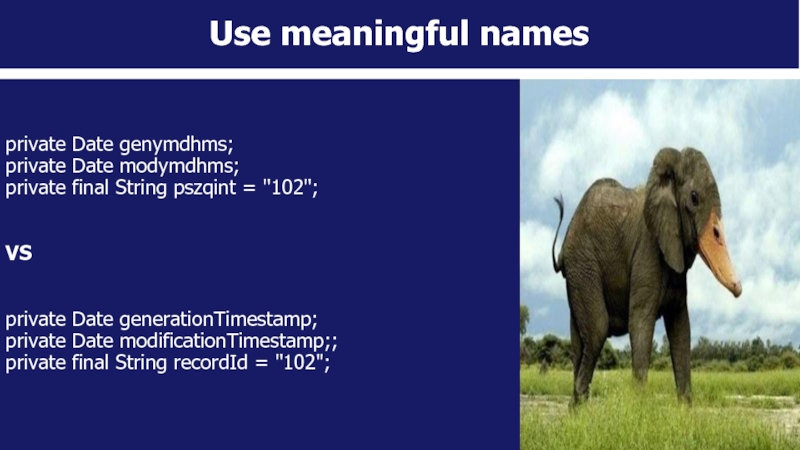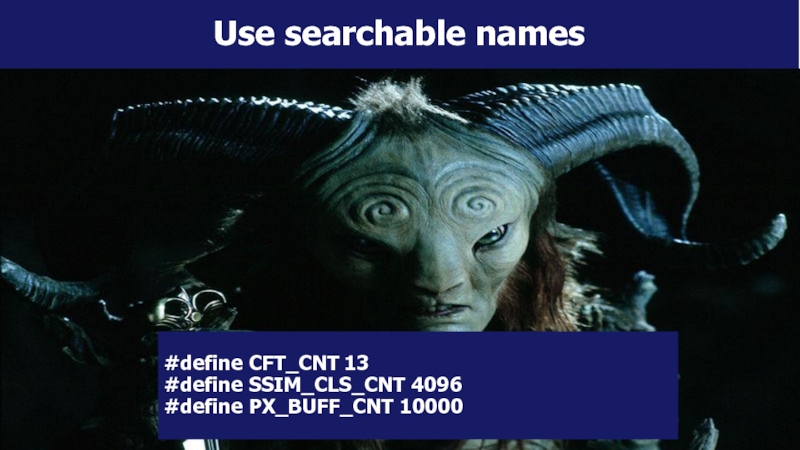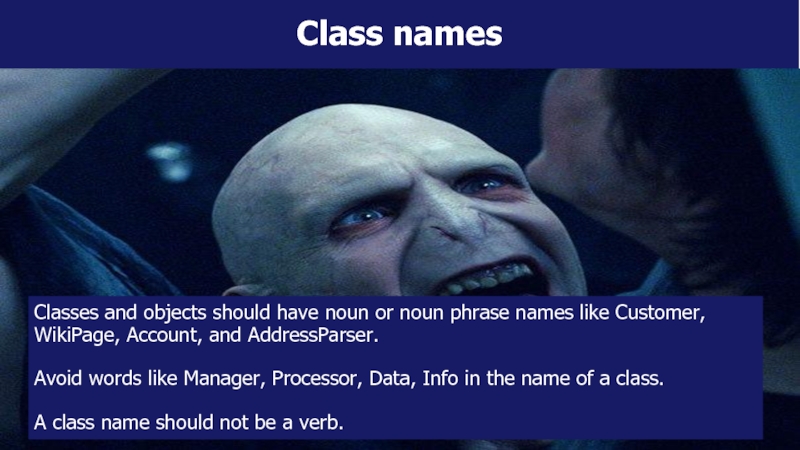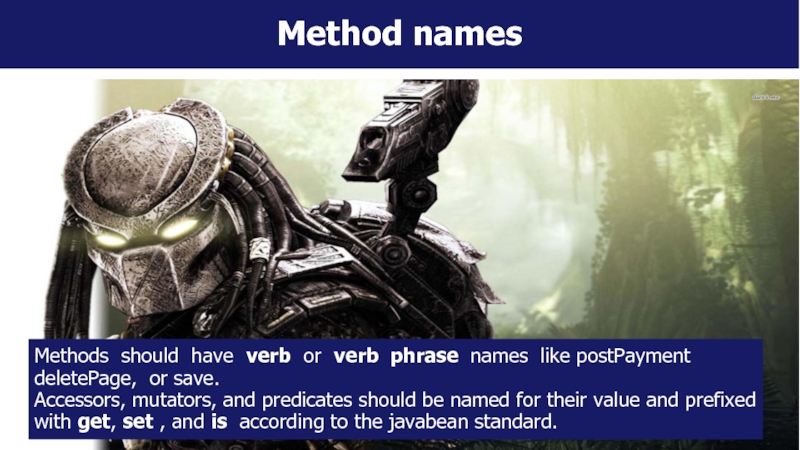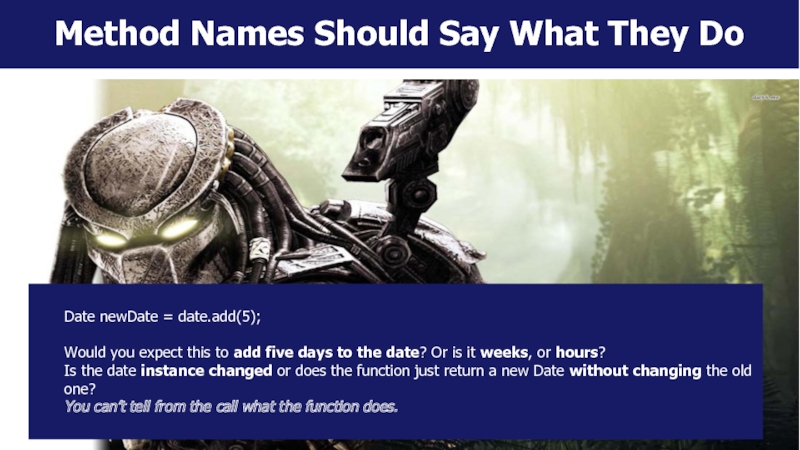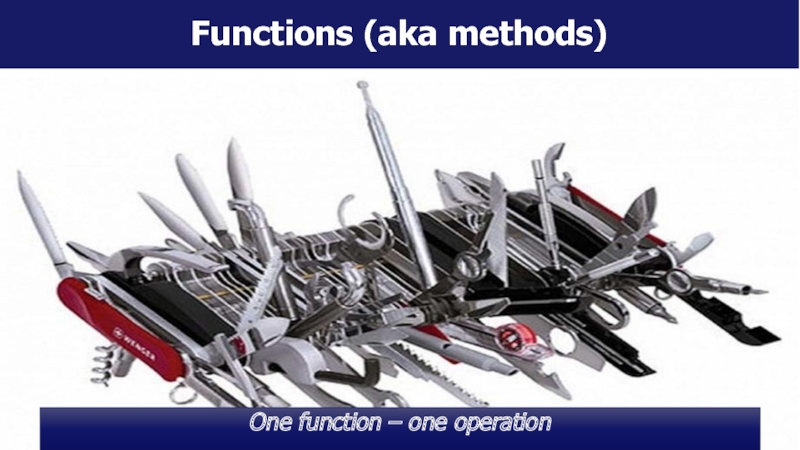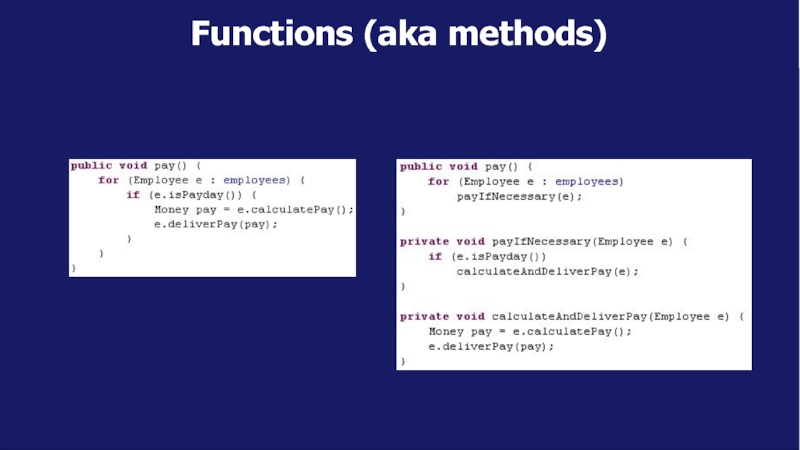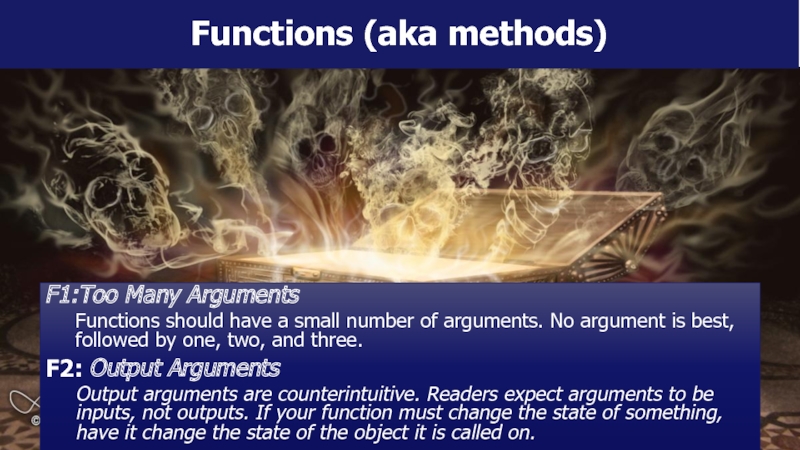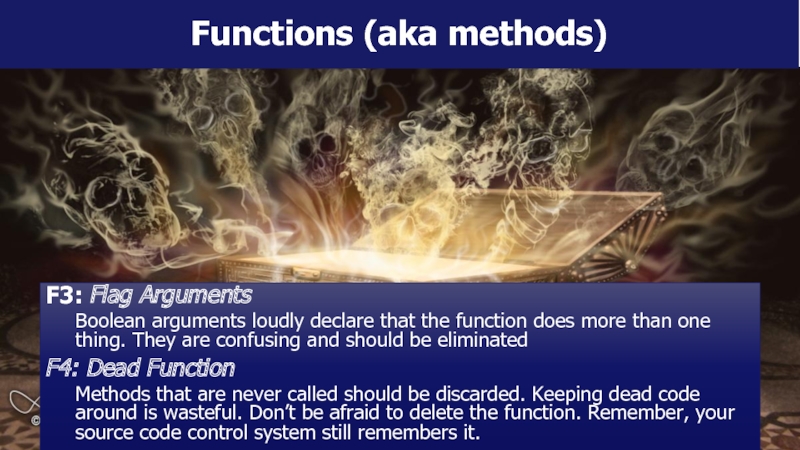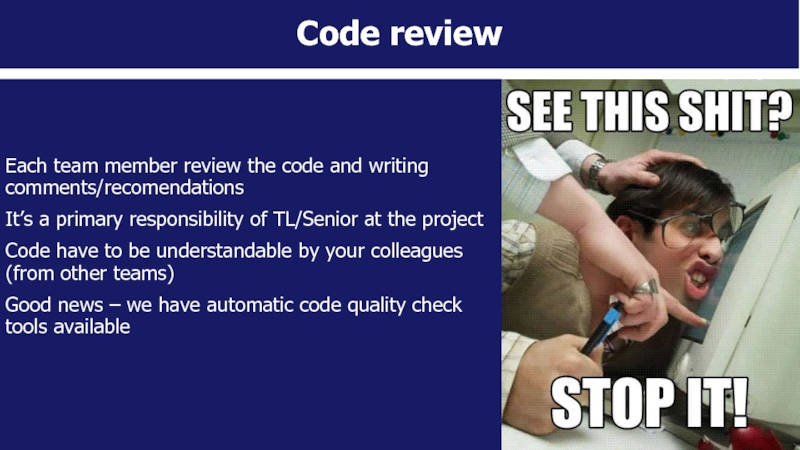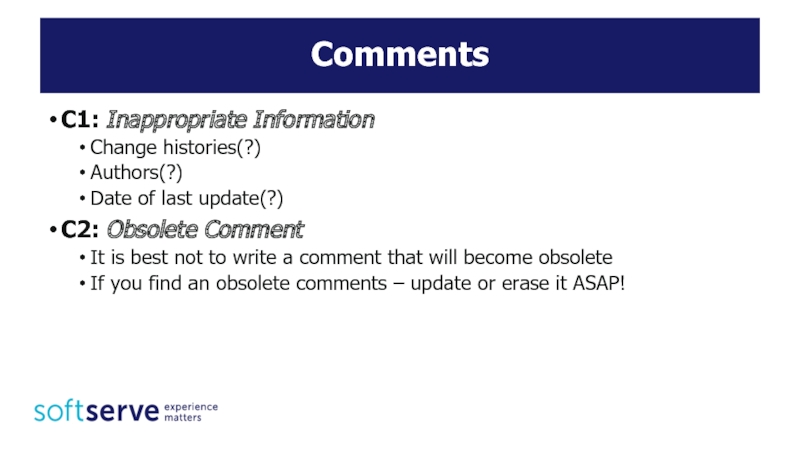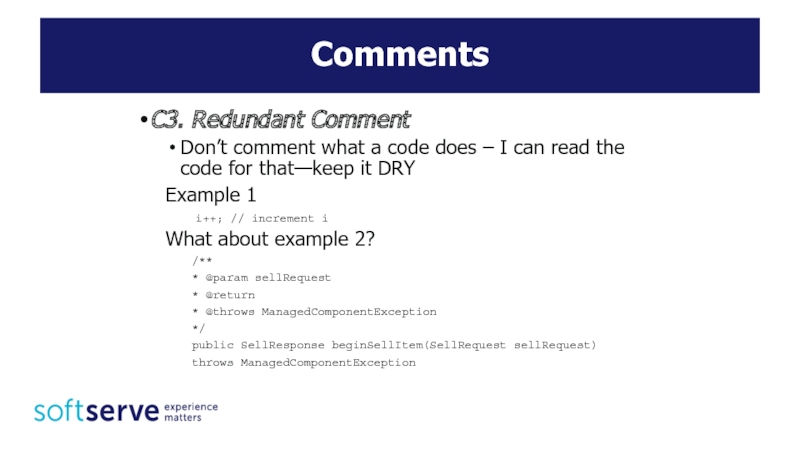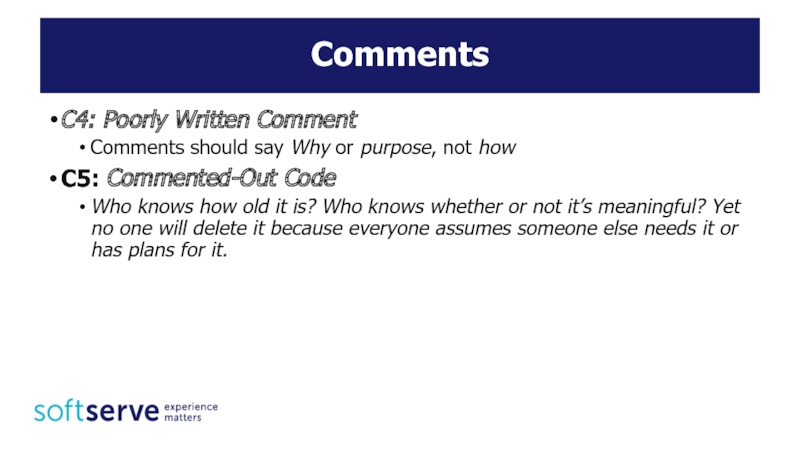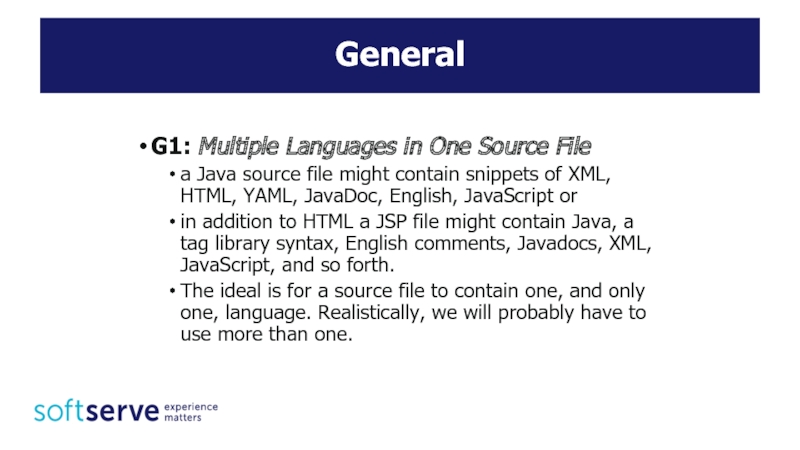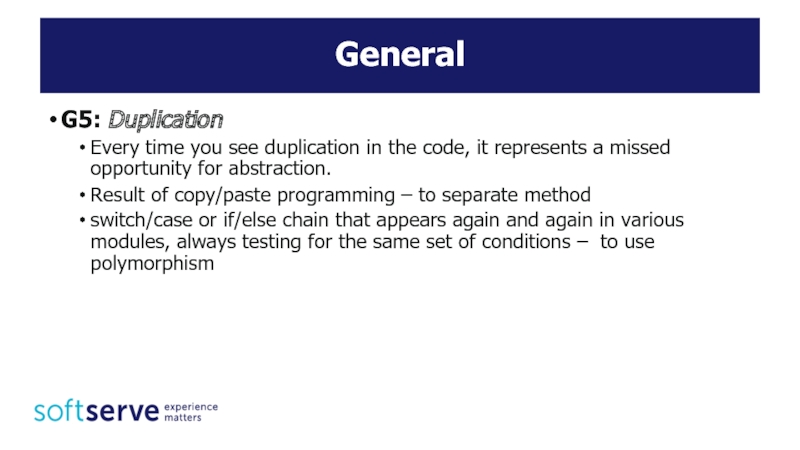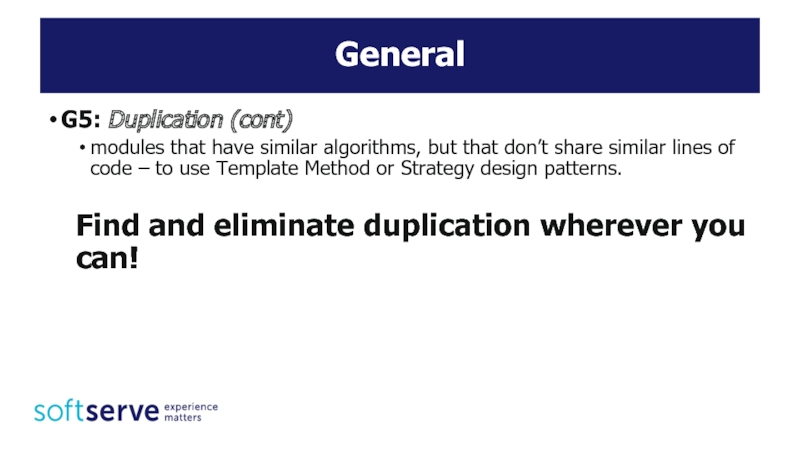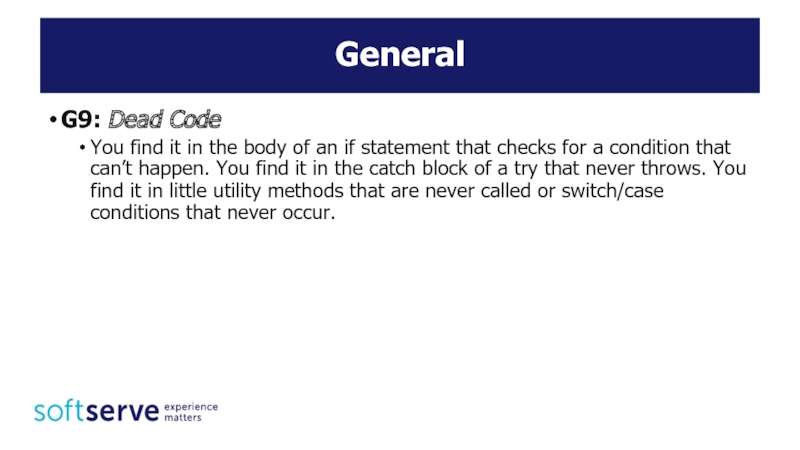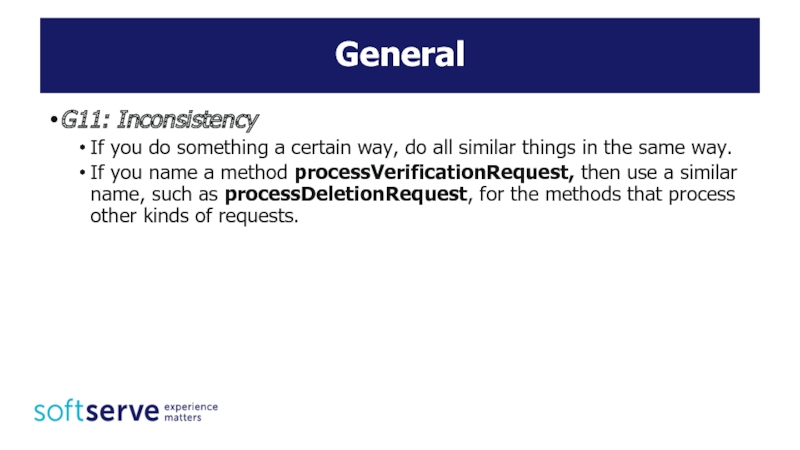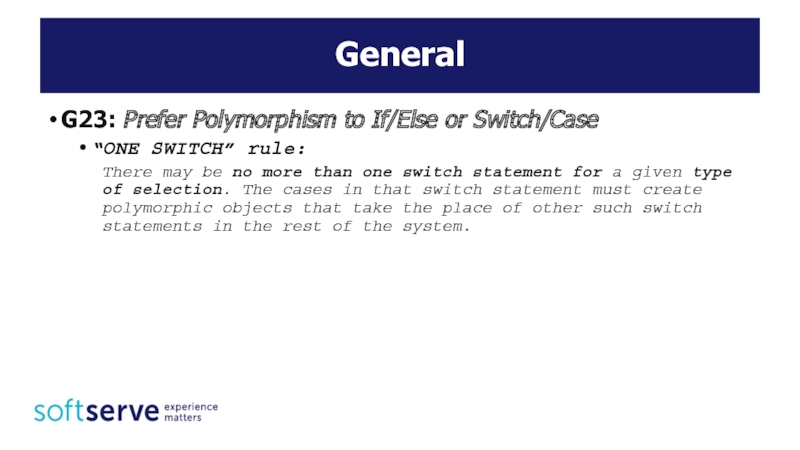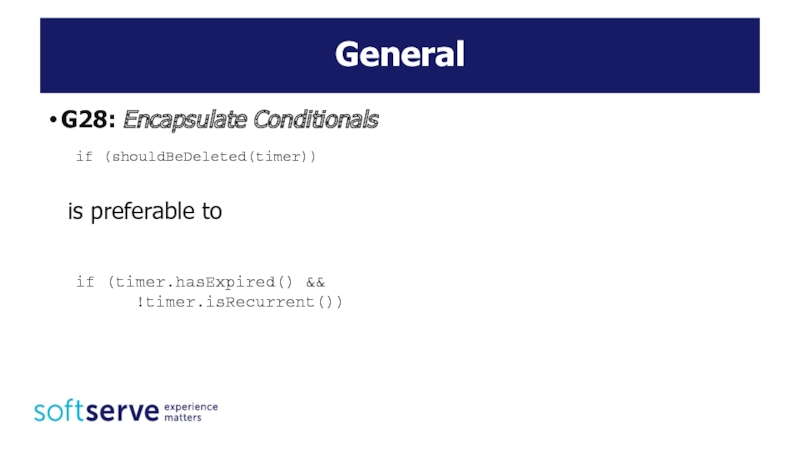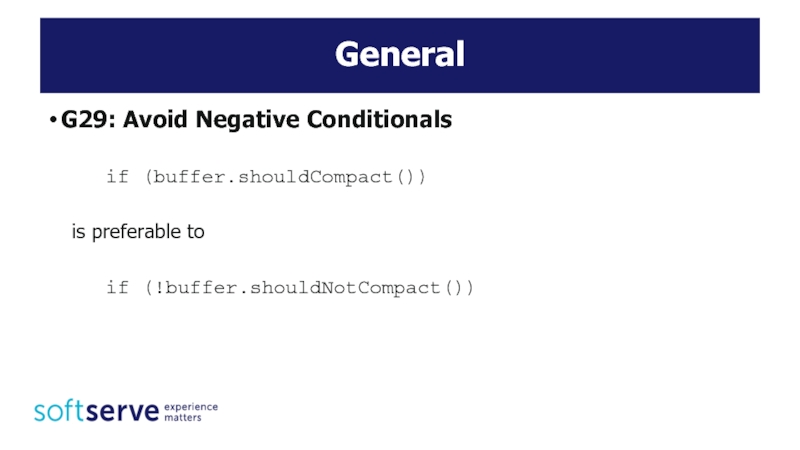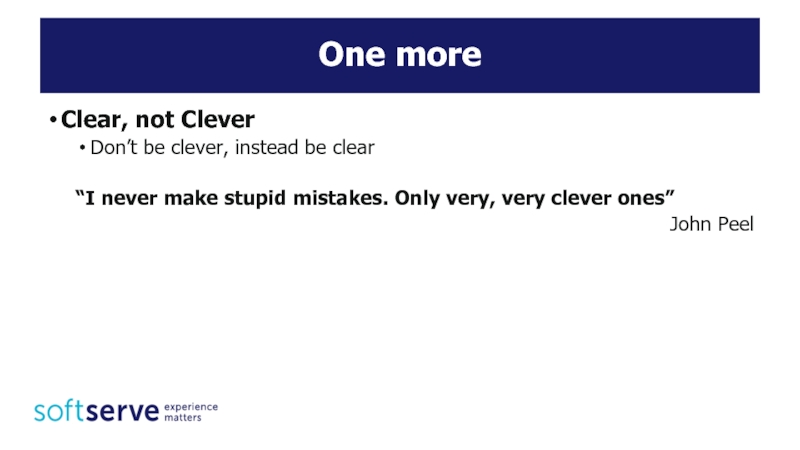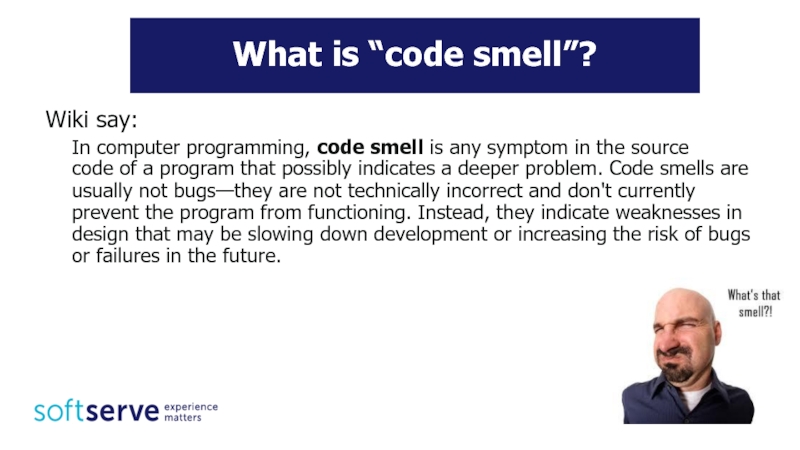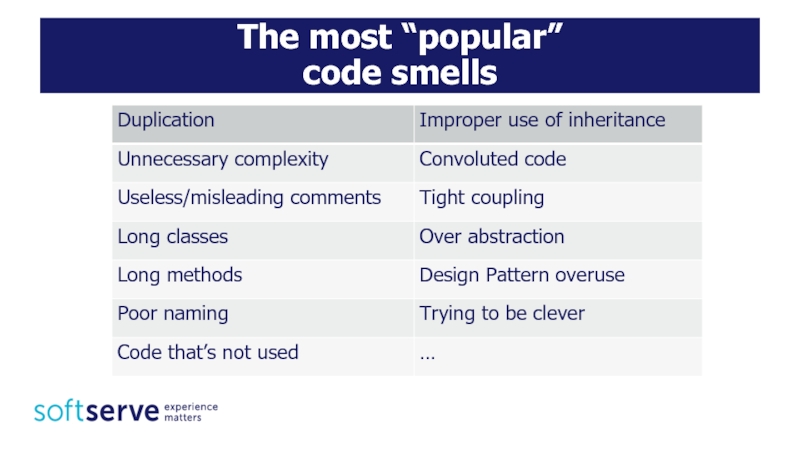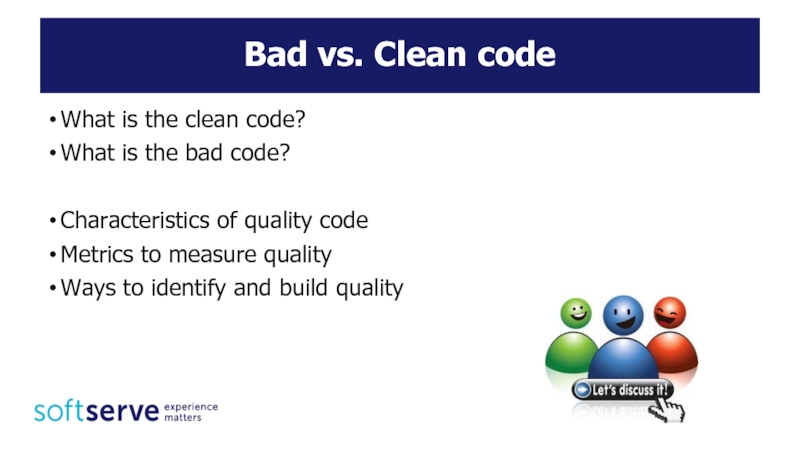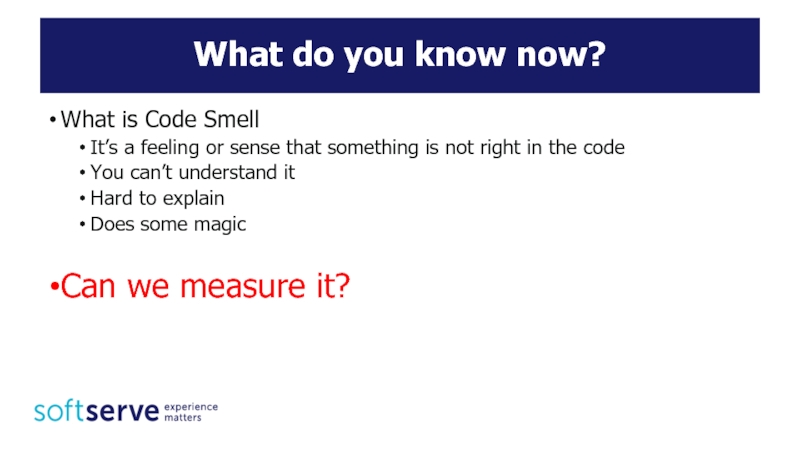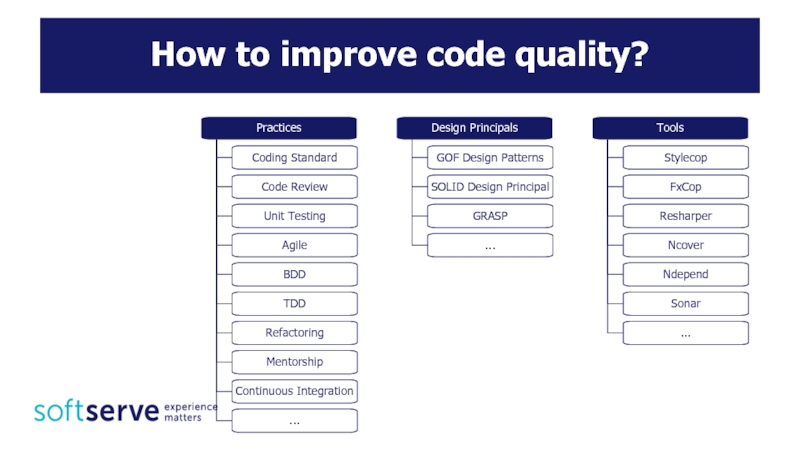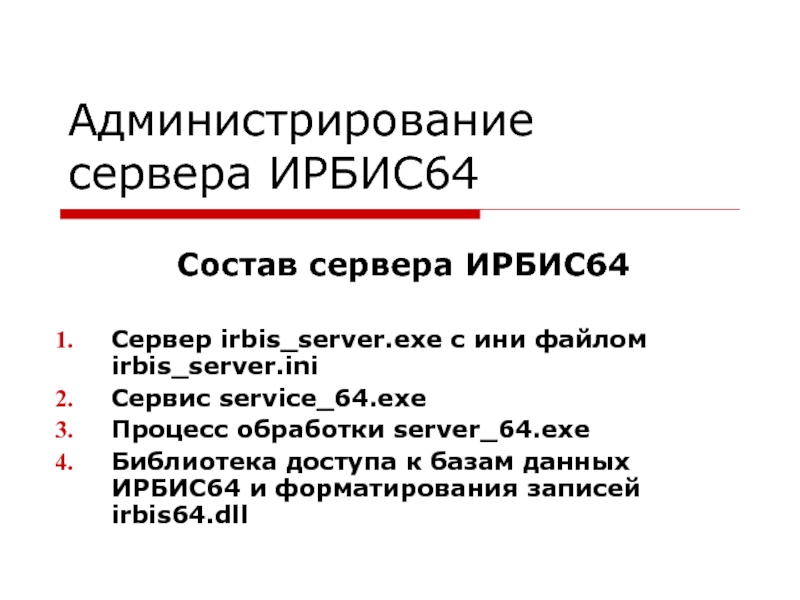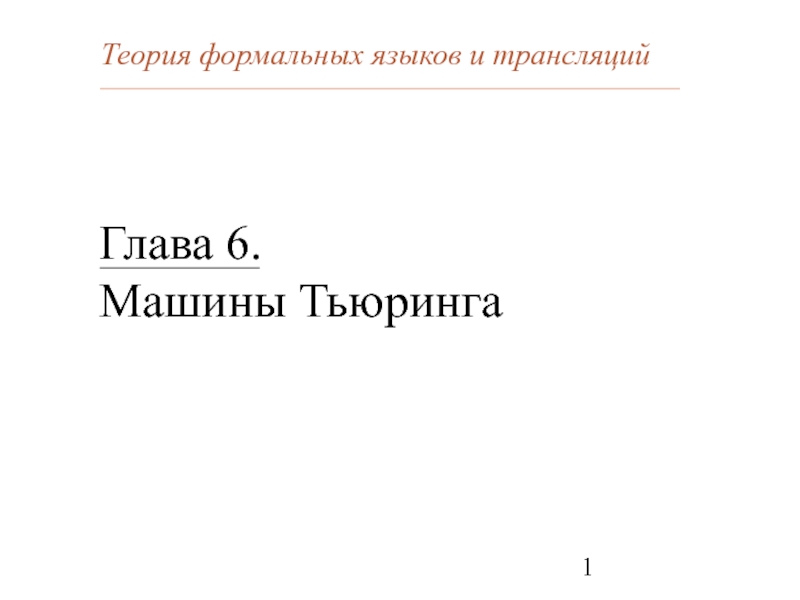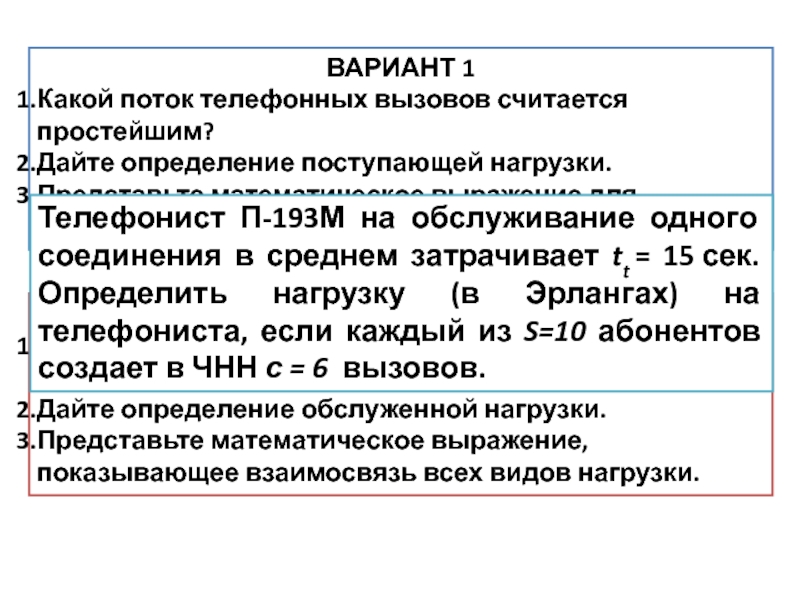- Главная
- Разное
- Дизайн
- Бизнес и предпринимательство
- Аналитика
- Образование
- Развлечения
- Красота и здоровье
- Финансы
- Государство
- Путешествия
- Спорт
- Недвижимость
- Армия
- Графика
- Культурология
- Еда и кулинария
- Лингвистика
- Английский язык
- Астрономия
- Алгебра
- Биология
- География
- Детские презентации
- Информатика
- История
- Литература
- Маркетинг
- Математика
- Медицина
- Менеджмент
- Музыка
- МХК
- Немецкий язык
- ОБЖ
- Обществознание
- Окружающий мир
- Педагогика
- Русский язык
- Технология
- Физика
- Философия
- Химия
- Шаблоны, картинки для презентаций
- Экология
- Экономика
- Юриспруденция
Code quality презентация
Содержание
- 1. Code quality
- 2. Tell me, what is a clean code for you?
- 3. for (i = 0;i < strlen(line);i++)
- 4. void CEquation::trio(double array[][rt+1],double alfa[][rt+1]) { for (int L = 0; L
- 5. Good vs Bad
- 6. How to write beautiful code There are
- 7. 80% of the lifetime cost of a
- 8. Why do we see a bad code?
- 10. Naming is important
- 11. The name should represent the developer’s idea
- 12. The name should represent the developer’s idea
- 13. The name should represent the developer’s idea
- 14. Use meaningful difference
- 15. Use meaningful names
- 16. Use searchable names #define
- 17. Class names Classes and objects should have
- 18. Method names Methods should have verb or
- 19. Method Names Should Say What They Do
- 20. One function – one operation Functions (aka methods)
- 21. Functions (aka methods)
- 22. F1:Too Many Arguments Functions should have a
- 23. F3: Flag Arguments Boolean arguments loudly declare
- 24. I’ll leave the project when complete all my technical debt
- 25. Code review Each team member review
- 26. Comments C1: Inappropriate Information Change histories(?) Authors(?)
- 27. Comments C3. Redundant Comment Don’t comment what
- 28. Comments C4: Poorly Written Comment Comments should
- 29. General G1: Multiple Languages in One Source
- 30. General G5: Duplication Every time you see
- 31. General G5: Duplication (cont) modules that have
- 32. General G6: Code at Wrong Level of
- 33. General G7: Base Classes Depending on Their
- 34. General G9: Dead Code You find it
- 35. General G11: Inconsistency If you do something
- 36. General G23: Prefer Polymorphism to If/Else or
- 37. General G28: Encapsulate Conditionals if (shouldBeDeleted(timer))
- 38. General G29: Avoid Negative Conditionals if (buffer.shouldCompact()) is preferable to if (!buffer.shouldNotCompact())
- 39. General G35: Keep Configurable Data at High Levels
- 40. One more Clear, not Clever Don’t be
- 41. What is “code smell”? Wiki say:
- 42. The most “popular” code smells
- 43. Bad vs. Clean code What is the
- 44. What do you know now? What is
- 45. How to improve code quality?
- 46. Thank you for attention! www.iot.lviv.ua www.facebook.com/iotlvivua viruslviv@gmail.com
Слайд 3 for (i = 0;i < strlen(line);i++) { short char_code =
isupper(line[i]) ? line[i] - 64 : line[i] - 96;
if (char_code > 0 && char_code < 27) {
printf("%c", isupper(line[i]) ?
((char_code + step) % 26 + 64) : ((char_code + step) % 26 + 96));
} else {
printf("%c", line[i]);
}
}
Слайд 6How to write beautiful code
There are two parts to learning craftsmanship:
knowledge and work. You must gain the knowledge of principles, patterns, practices, and heuristics that a craftsman knows, and you must also grind that knowledge into your fingers, eyes, and gut by working hard and practicing.
(Robert C. Martin, Clean code)
(Robert C. Martin, Clean code)
Слайд 780% of the lifetime cost of a piece of software goes
to maintenance.
Hardly any software is maintained for its whole life by the original author.
Code quality improve the readability of the software, allowing engineers to understand new code more quickly and thoroughly.
Hardly any software is maintained for its whole life by the original author.
Code quality improve the readability of the software, allowing engineers to understand new code more quickly and thoroughly.
Why its important?
Слайд 8Why do we see a bad code?
Time: I don't have a
time
We never seem to have time to do it, but always seem find time to redo it?!
Knowledge: what is a good code?
Tools: I don’t know about it
Skills: I can’t do it
We never seem to have time to do it, but always seem find time to redo it?!
Knowledge: what is a good code?
Tools: I don’t know about it
Skills: I can’t do it
Слайд 11The name should represent the developer’s idea
int d; // time from
beginning
int elapsedTimeInDays;
int daysSinceCreation;
int daysSinceModification;
int elapsedTimeInDays;
int daysSinceCreation;
int daysSinceModification;
Слайд 12The name should represent the developer’s idea
public List getThem() {
List list1
= new ArrayList();
for (int[] x : theList)
if (x[0] == 4)
list1.add(x);
return list1;
}
What kinds of things are in theList?
What is the significance of the zeroth subscript of an item in theList?
What is the significance of the value?
How would I use the list being returned?
for (int[] x : theList)
if (x[0] == 4)
list1.add(x);
return list1;
}
What kinds of things are in theList?
What is the significance of the zeroth subscript of an item in theList?
What is the significance of the value?
How would I use the list being returned?
Слайд 13The name should represent the developer’s idea
public List getFlaggedCells() {
List flaggedCells
= new ArrayList();
for (int[] cell : gameBoard)
if (cell[STATUS_VALUE] == FLAGGED)
flaggedCells.add(cell);
return flaggedCells;
}
for (int[] cell : gameBoard)
if (cell[STATUS_VALUE] == FLAGGED)
flaggedCells.add(cell);
return flaggedCells;
}
Слайд 14Use meaningful difference
public static void copyChars(char a1[], char a2[]) {
for (int
i = 0; i < a1.length; i++) {
a2[i] = a1[i];
}
} VS
source and destination are used for the argument
names
a2[i] = a1[i];
}
} VS
source and destination are used for the argument
names
Слайд 15Use meaningful names
private Date genymdhms;
private Date modymdhms;
private final String pszqint
= "102";
VS
private Date generationTimestamp;
private Date modificationTimestamp;;
private final String recordId = "102";
VS
private Date generationTimestamp;
private Date modificationTimestamp;;
private final String recordId = "102";
Слайд 17Class names
Classes and objects should have noun or noun phrase names
like Customer, WikiPage, Account, and AddressParser.
Avoid words like Manager, Processor, Data, Info in the name of a class.
A class name should not be a verb.
Слайд 18Method names
Methods should have verb or verb phrase names like postPayment
deletePage, or save.
Accessors, mutators, and predicates should be named for their value and prefixed with get, set , and is according to the javabean standard.
Accessors, mutators, and predicates should be named for their value and prefixed with get, set , and is according to the javabean standard.
Слайд 19Method Names Should Say What They Do
Date newDate = date.add(5);
Would you
expect this to add five days to the date? Or is it weeks, or hours?
Is the date instance changed or does the function just return a new Date without changing the old one?
You can’t tell from the call what the function does.
Is the date instance changed or does the function just return a new Date without changing the old one?
You can’t tell from the call what the function does.
Слайд 22F1:Too Many Arguments
Functions should have a small number of arguments. No
argument is best, followed by one, two, and three.
F2: Output Arguments
Output arguments are counterintuitive. Readers expect arguments to be inputs, not outputs. If your function must change the state of something, have it change the state of the object it is called on.
F2: Output Arguments
Output arguments are counterintuitive. Readers expect arguments to be inputs, not outputs. If your function must change the state of something, have it change the state of the object it is called on.
Functions (aka methods)
Слайд 23F3: Flag Arguments
Boolean arguments loudly declare that the function does more
than one thing. They are confusing and should be eliminated
F4: Dead Function
Methods that are never called should be discarded. Keeping dead code around is wasteful. Don’t be afraid to delete the function. Remember, your source code control system still remembers it.
F4: Dead Function
Methods that are never called should be discarded. Keeping dead code around is wasteful. Don’t be afraid to delete the function. Remember, your source code control system still remembers it.
Functions (aka methods)
Слайд 25Code review
Each team member review the code and writing comments/recomendations
It’s
a primary responsibility of TL/Senior at the project
Code have to be understandable by your colleagues (from other teams)
Good news – we have automatic code quality check tools available
Code have to be understandable by your colleagues (from other teams)
Good news – we have automatic code quality check tools available
Слайд 26Comments
C1: Inappropriate Information
Change histories(?)
Authors(?)
Date of last update(?)
C2: Obsolete Comment
It is best
not to write a comment that will become obsolete
If you find an obsolete comments – update or erase it ASAP!
If you find an obsolete comments – update or erase it ASAP!
Слайд 27Comments
C3. Redundant Comment
Don’t comment what a code does – I can
read the code for that—keep it DRY
Example 1
i++; // increment i
What about example 2?
/**
* @param sellRequest
* @return
* @throws ManagedComponentException
*/
public SellResponse beginSellItem(SellRequest sellRequest)
throws ManagedComponentException
Example 1
i++; // increment i
What about example 2?
/**
* @param sellRequest
* @return
* @throws ManagedComponentException
*/
public SellResponse beginSellItem(SellRequest sellRequest)
throws ManagedComponentException
Слайд 28Comments
C4: Poorly Written Comment
Comments should say Why or purpose, not how
C5:
Commented-Out Code
Who knows how old it is? Who knows whether or not it’s meaningful? Yet no one will delete it because everyone assumes someone else needs it or has plans for it.
Who knows how old it is? Who knows whether or not it’s meaningful? Yet no one will delete it because everyone assumes someone else needs it or has plans for it.
Слайд 29General
G1: Multiple Languages in One Source File
a Java source file might
contain snippets of XML, HTML, YAML, JavaDoc, English, JavaScript or
in addition to HTML a JSP file might contain Java, a tag library syntax, English comments, Javadocs, XML, JavaScript, and so forth.
The ideal is for a source file to contain one, and only one, language. Realistically, we will probably have to use more than one.
in addition to HTML a JSP file might contain Java, a tag library syntax, English comments, Javadocs, XML, JavaScript, and so forth.
The ideal is for a source file to contain one, and only one, language. Realistically, we will probably have to use more than one.
Слайд 30General
G5: Duplication
Every time you see duplication in the code, it represents
a missed opportunity for abstraction.
Result of copy/paste programming – to separate method
switch/case or if/else chain that appears again and again in various modules, always testing for the same set of conditions – to use polymorphism
Result of copy/paste programming – to separate method
switch/case or if/else chain that appears again and again in various modules, always testing for the same set of conditions – to use polymorphism
Слайд 31General
G5: Duplication (cont)
modules that have similar algorithms, but that don’t share
similar lines of code – to use Template Method or Strategy design patterns.
Find and eliminate duplication wherever you can!
Find and eliminate duplication wherever you can!
Слайд 32General
G6: Code at Wrong Level of Abstraction
Good software design requires that
we separate concepts at different levels and place them in different containers
Слайд 33General
G7: Base Classes Depending on Their Derivatives
The most common reason for
partitioning concepts into base and derivative classes is so that the higher level base class concepts can be independent of the lower level derivative class concepts.
Слайд 34General
G9: Dead Code
You find it in the body of an if
statement that checks for a condition that can’t happen. You find it in the catch block of a try that never throws. You find it in little utility methods that are never called or switch/case conditions that never occur.
Слайд 35General
G11: Inconsistency
If you do something a certain way, do all similar
things in the same way.
If you name a method processVerificationRequest, then use a similar name, such as processDeletionRequest, for the methods that process other kinds of requests.
If you name a method processVerificationRequest, then use a similar name, such as processDeletionRequest, for the methods that process other kinds of requests.
Слайд 36General
G23: Prefer Polymorphism to If/Else or Switch/Case
“ONE SWITCH” rule:
There may
be no more than one switch statement for a given type of selection. The cases in that switch statement must create polymorphic objects that take the place of other such switch statements in the rest of the system.
Слайд 37General
G28: Encapsulate Conditionals
if (shouldBeDeleted(timer))
is preferable to
if (timer.hasExpired() &&
!timer.isRecurrent())
Слайд 38General
G29: Avoid Negative Conditionals
if (buffer.shouldCompact())
is preferable to
if (!buffer.shouldNotCompact())
Слайд 40One more
Clear, not Clever
Don’t be clever, instead be clear
“I never make
stupid mistakes. Only very, very clever ones”
John Peel
John Peel
Слайд 41What is “code smell”?
Wiki say:
In computer programming, code smell is any symptom in the source code of
a program that possibly indicates a deeper problem. Code smells are usually not bugs—they are not technically incorrect and don't currently prevent the program from functioning. Instead, they indicate weaknesses in design that may be slowing down development or increasing the risk of bugs or failures in the future.
Слайд 43Bad vs. Clean code
What is the clean code?
What is the bad
code?
Characteristics of quality code
Metrics to measure quality
Ways to identify and build quality
Characteristics of quality code
Metrics to measure quality
Ways to identify and build quality
Слайд 44What do you know now?
What is Code Smell
It’s a feeling or
sense that something is not right in the code
You can’t understand it
Hard to explain
Does some magic
Can we measure it?
You can’t understand it
Hard to explain
Does some magic
Can we measure it?
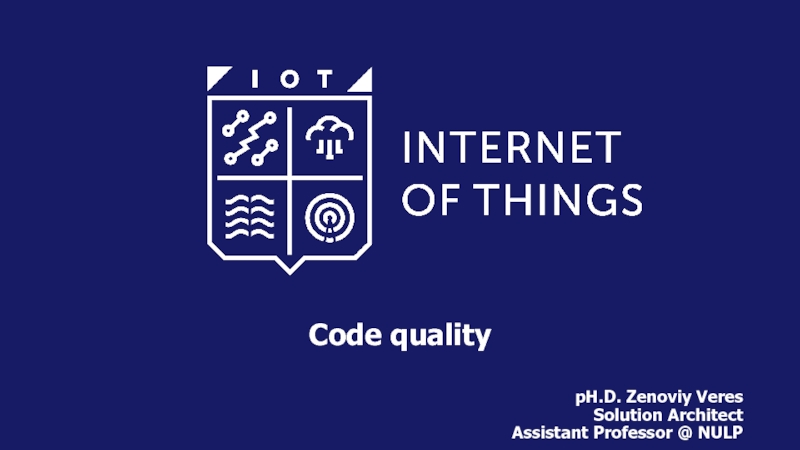
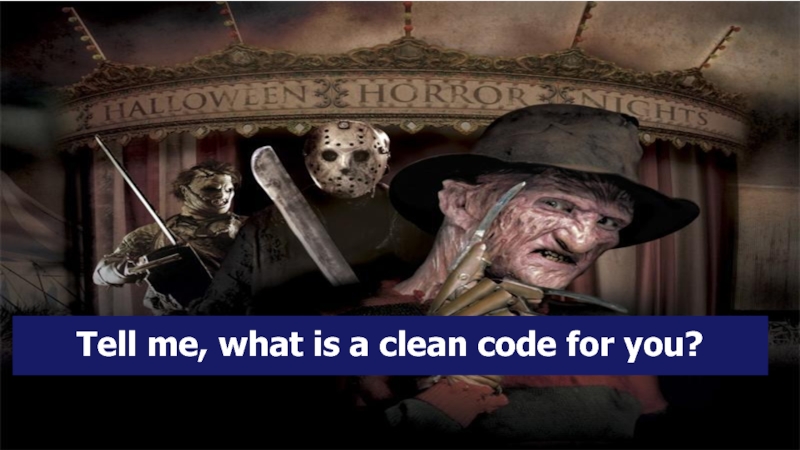
![for (i = 0;i < strlen(line);i++) { short char_code = isupper(line[i]) ?](/img/tmb/4/358545/b774a07a5c993fda8304ef5eefe96228-800x.jpg)
![void CEquation::trio(double array[][rt+1],double alfa[][rt+1]) { for (int L = 0; L](/img/tmb/4/358545/f9e99281155ca6f97653c21941882ffa-800x.jpg)

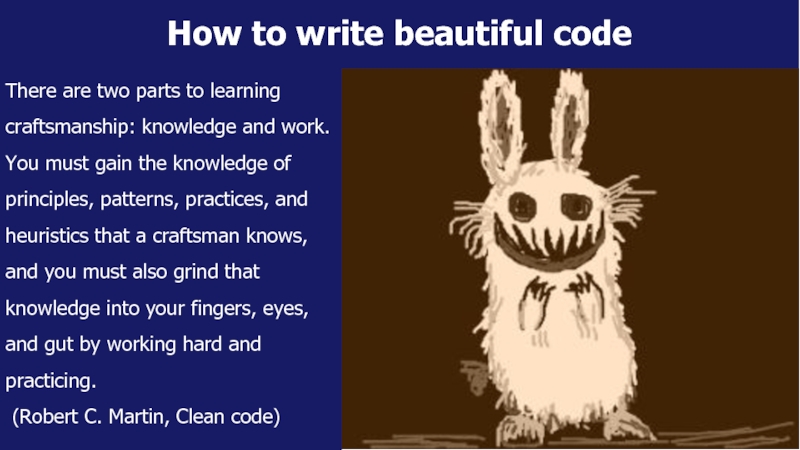
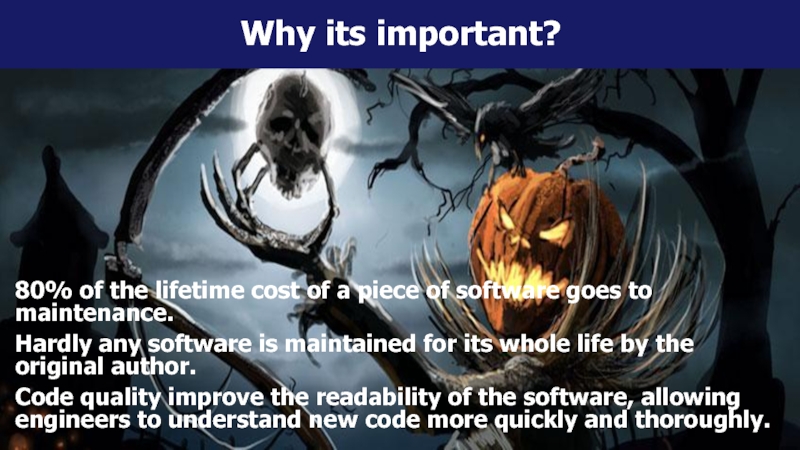
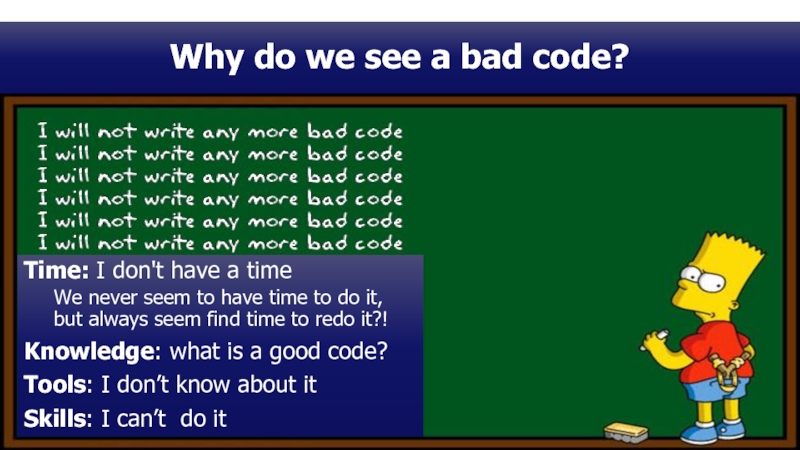

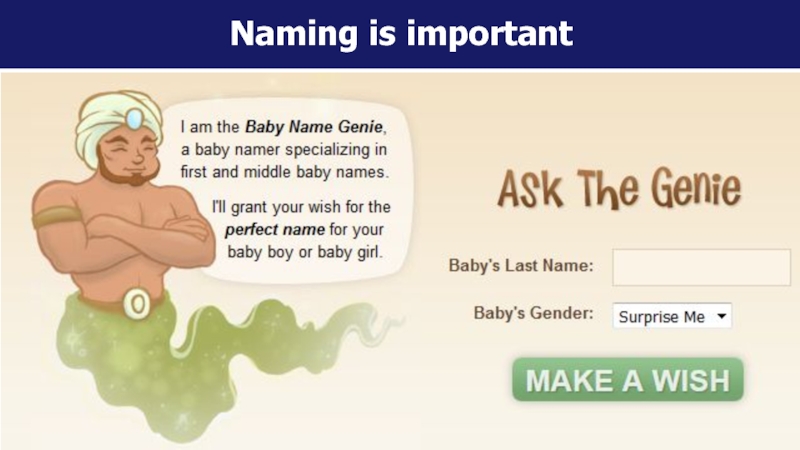
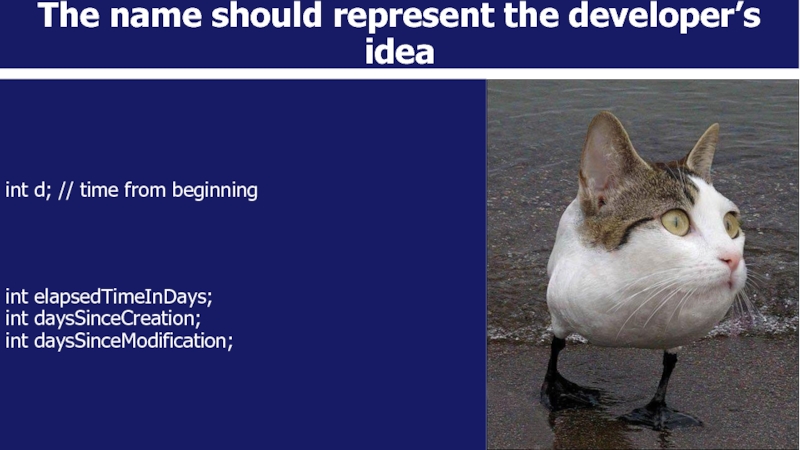
![The name should represent the developer’s ideapublic List getThem() { List list1 = new ArrayList(); for (int[]](/img/tmb/4/358545/56a4f139ec2d13ca218b851b5706e322-800x.jpg)
![The name should represent the developer’s ideapublic List getFlaggedCells() { List flaggedCells = new ArrayList(); for (int[]](/img/tmb/4/358545/f633d7e82c276a6ad86101255b9d03e9-800x.jpg)
![Use meaningful differencepublic static void copyChars(char a1[], char a2[]) { for (int i = 0; i](/img/tmb/4/358545/c3dc4fb8f9294e958029e6ff71cc7674-800x.jpg)
